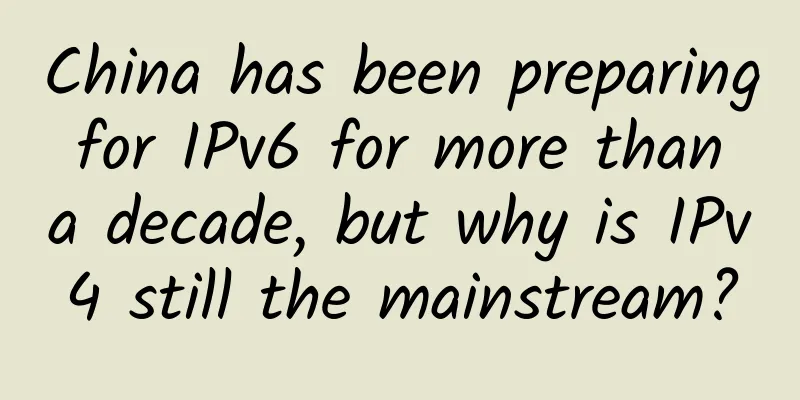China has been preparing for IPv6 for more than a decade, but why is IPv4 still the mainstream?

|
It is understood that IPv6 was first introduced into China by CERNET in 1998. As early as 2003, China put the development of IPv6 on the agenda. This was a very correct and timely strategic decision. After five years of development, the first phase achieved the predetermined strategic goals. However, after 2008, the development speed of IPv6 in my country began to slow down and began to lag behind the international level. It can be said that China got up early but arrived late. China is having a hard time promoting IPv6. There are six reasons for this: 1. It is difficult to extricate oneself from the trap of private addresses. Address translation (NAT) can temporarily address the problem of insufficient IPv4 public network addresses, but the management of private addresses across multiple public network addresses is quite complicated. NAT destroys end-to-end transparency and cannot trace the user. Second, the government lacks clear market orientation and awareness of application-first. In developed countries, the military and government generally switch to IPv6 first, while our country’s government websites have not played the leading role they should have. 3. Insufficient attention is paid to the bottleneck of content services and there is a lack of favorable policies. "The entire IPv6 port in my country has not been opened yet, the international bandwidth is not enough, foreign IPv6 services have not been implemented in China, and the migration of IPv6 in applications and websites is lagging behind. These have seriously hindered the development of IPv6 in my country. Fourth, some misunderstandings and interferences have affected the implementation of the national IPv6 development strategy. Wu Hequan said that some plans to isolate China's public Internet from the international Internet have misled some units by claiming to be "independently innovative, safe and reliable", which violates China's insistence on a global Internet. In addition, some people think that the future network that subverts IP will soon be realized, and are in a wait-and-see state, and do not take any action on IPv6 deployment. 5. The Internet lacks due international competition. Large ISPs such as Google and Facebook have already migrated a large number of applications to IPv6. Some ISPs in my country have also migrated some applications, but they no longer provide deep-level services. 6. The cost and price of my country's Internet security regulatory measures are very high. In terms of IPv6, the entire system needs to be rebuilt after the migration. (1) Complexity of Migration To smoothly transition operations from IPv4 to IPv6, companies must audit, review, upgrade, reconfigure and test their entire technology infrastructure. Everything from routers and servers to smartphones, PCs, laptops and other connected devices must be upgraded to make the transition, and the way the business operates and formulates policies must also change accordingly. (2) The issue of return on investment Given the complexity of the migration process, it involves a lot of time and money. In addition to the cost of software and hardware upgrades, companies also need to plan and execute in a timely manner. The investment cost is too high, but the benefits are very low. Therefore, neither hardware manufacturers nor ISPs have enough market driving force to promote large-scale IPv6 network transformation. On the other hand, there is no ideal smooth evolution plan in the migration from IPv4 to IPv6, and there are considerable risks. (3) Traditional hardware issues When the transition occurs, networked devices may require dual-stack configuration: that is, IPv4 addresses and IPv6 addresses. Old devices that do not support IPv6 addresses may cause network communication problems and eventually become a burden. Terminals are the weak link in the development of IPv6. Currently, most commercial fixed-line terminals and mobile phones do not support IPv6. Measures to accelerate the large-scale deployment of IPv6: 1. The General Office of the CPC Central Committee and the General Office of the State Council issued the Action Plan for Promoting Large-Scale Deployment of Internet Protocol Version 6 (IPv6), which clearly puts forward three main goals: 1. By the end of 2018, the number of active IPv6 users will reach 200 million, accounting for no less than 20% of Internet users; 2. By the end of 2020, the number of active IPv6 users will exceed 500 million, accounting for more than 50% of Internet users, and new network addresses will no longer use private IPv4 addresses; 3. By the end of 2025, networks, applications, and terminals will fully support IPv6, completing a smooth evolution and upgrade to the next generation of the Internet. To implement the spirit of the document "Action Plan for Promoting Large-Scale Deployment of Internet Protocol Version 6 (IPv6)" issued by the General Office of the CPC Central Committee and the State Council, and with the strong support of the National Next Generation Internet Industry Technology Innovation Strategic Alliance, the Qinhuangdao Development Zone Management Committee has upgraded all 88 management modules including its government website and various branches to IPv6. 2. The National Engineering Center for Next Generation Internet has recently officially announced the launch of IPv6 public DNS: 240c::6666, and backup DNS: 240c::6644. This is a DNS service provided free of charge to the public, which will undoubtedly provide a great choice for global IPv6 users to optimize their Internet experience. Its three major features of accuracy, speed, security, stability, and DNS64 will fully guarantee the efficiency and stability of IPv6 networks. As a result, my country's Internet environment will undergo earth-shaking changes in the next few years. Let us wait and see. |
<<: The Importance of Switchgear to Data Center Uptime
Recommend
AT&T's plan to shut down its 3G network has been repeatedly blocked. The security industry says it will cause public safety risks.
[[422256]] AT&T's plan to shut down its 3...
What is a mesh Wi-Fi router? What makes it so cool?
No matter how big or small your house or apartmen...
The most powerful remote access tool, no objection
ZeroTier and TailScale are foreign brand solution...
SpartanHost: Seattle high-defense KVM 20% off, starting at $4 per month, 1G memory, 15GB NVMe hard drive, 2TB/10Gbps bandwidth
SpartanHost, also known as Spartan, is a foreign ...
Does the cloud-native 5G core network need a DPU?
In 2022, the number of 5G connections worldwide w...
Which groups are suitable for using software development cloud (various services)?
[[178931]] The application scenarios of various s...
[Black Friday] ExtraVM: 50% off VPS with 2GB or more memory, 1Gbps unlimited traffic, data centers in Los Angeles/Dallas/Netherlands
ExtraVM's 2023 Black Friday event is mainly f...
Security monitoring and observability capability building based on system operation experience
Observability refers to the ability to measure th...
Hundreds of millions of "5G users" have subscribed to packages but have not yet accessed the Internet
The penetration rates of 5G packages for China Te...
Woman connected to WiFi and received a huge bill: Some WiFi is actually charged
Nowadays, surfing the Internet with mobile termin...
Three key reasons why automakers are adopting 5G
Automakers are already taking the lead in incorpo...
How do base stations go to the sky?
[[348593]] This article is reprinted from the WeC...
TmhHost special package 4G memory 388 yuan/year, Los Angeles CN2 GIA/AS9929/Japan Softbank optional
TmhHost currently offers several special annual p...
Kerlink and Radio Bridge provide LoRaWAN solutions for private IoT networks
According to recent announcements, Kerlink and Ra...
BGPTO: Japan/Singapore CN2 GIA server $64/month, E3-1230v3/16GB/480G SSD/10-100M bandwidth
It's been a while since I shared information ...









